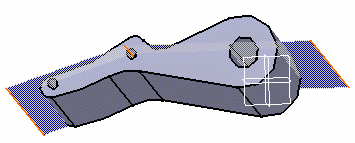Click Aligned Section Cut
 or Aligned Section View or Aligned Section View
 in the Views toolbar (Sections sub-toolbar).
in the Views toolbar (Sections sub-toolbar). The Tools Palette is displayed with only offset constraint:

Click to create the first point of the profile.
The Tools Palette
is now displayed with the following constraint options:

You can select any one of these constraints, Parallel, Perpendicular, Angle or Offset.
Note:
If you select the offset constraint to define the first segment, then the offset constraint is the active constraint. Otherwise, by default, the parallel constraint is the active constraint.
Click the appropriate constraint.
To set the direction of the profile, select one of the following valid reference element:
-
A generated line, such as an
edge, a center line or an axis line. In this case, the constraint will be associative
to the referenced 3D geometry.
- A generated circle. In this case, the constraints will be associative to the 3D.
-
One of the coordinates axis of the sheet. In this case, the constraint will not be associative to the 3D.
-
A sketched line. In this case, the constraint will not be associative to the 3D.
The Tools Palette becomes active again to allow
you to select another constraint for the next line.

The section plane also appears on the 3D part and moves dynamically on
the part.

Double-click to end the cutting profile creation.
Click to generate the view.

|